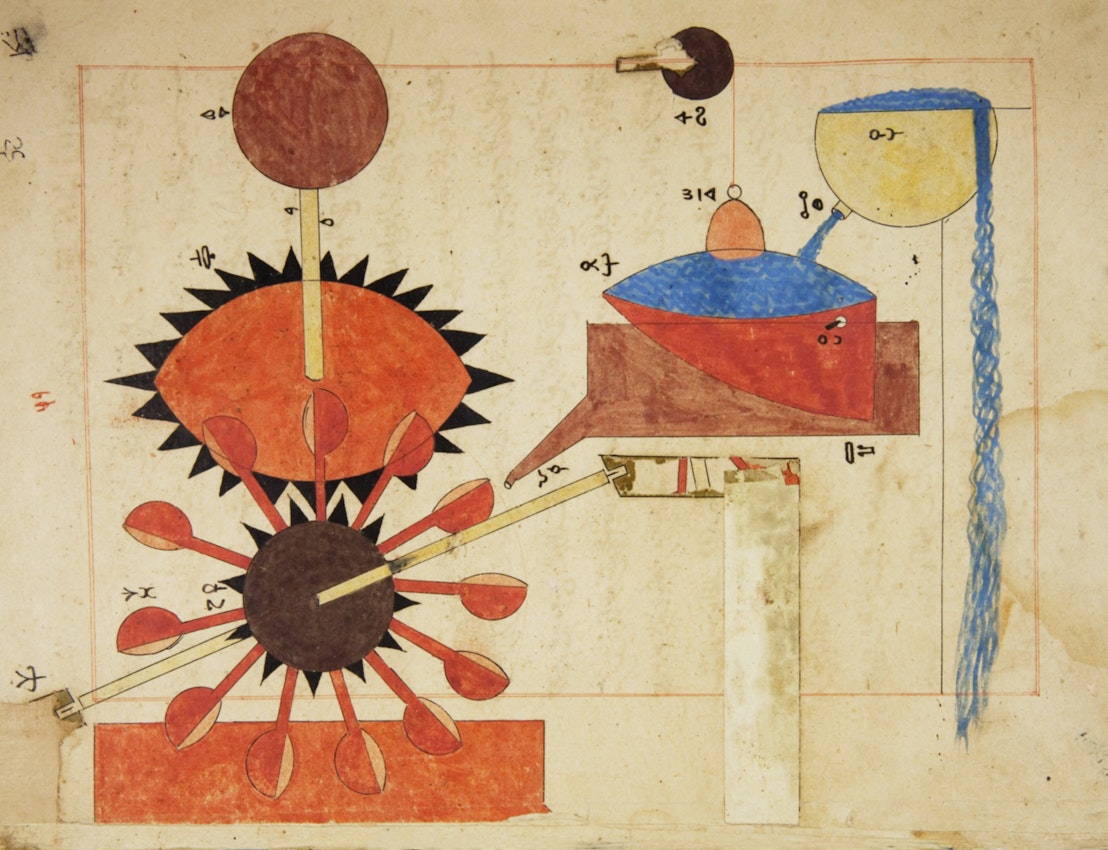
Manuscript of Ismail al-Jazarī’s Ingenious Mechanical Devices (ca. 17th century)
The images gathered below come from an anonymous copy of Ismail al-Jazarī’s thirteenth-century treatise on the construction of machines. While this copy is undated, it forms part of a manuscript (collecting various Arabic scientific texts) bound in the seventeenth century and preserved at Berlin’s Staatsbibliothek (Ms. or Fol. 3306).
Al-Jazarī, who passed away in 1206, served as the chief engineer for the court of the Artuqids in Diyarbakir. His Book of Knowledge of Ingenious Mechanical Devices lives up to its name, detailing lock-like devices for raising water, sophisticated zodiac clocks, avian automata able to produce song, and a showering system for King Salih, who “disliked a servant or slave girl pouring water onto his hands for him”. He invented bloodletting technologies, mischievous fountains, segmental gears, and a chest (sundūq) that featured a security system with four combination dials — presumably a safe for storing valued possessions — and has been subsequently dubbed “the father of robotics”, due to his creation of a life-like butler who could offer guests a hand towel after their ablutions. Al-Jazarī’s contemporaries already recognized his eminence as an engineer, referring to him as unique and unrivaled, learned and worthy. He stood on the shoulders of Persian, Greek, Indian, and Chinese precursors, while Renaissance inventors, in turn, stood on his.
The Book of Knowledge of Ingenious Mechanical Devices contains some fifty mechanical devices divided into six categories: clocks; vessels and figures for drinking sessions; pitchers, basins, and other washing devices; fountains and perpetual flutes; machines for raising water; and a miscellaneous category, where we find a self-closing door. The second category is perhaps the most intriguing, and grants some insight into the extravagant concerns of al-Jazarī’s courtly patrons. One machine — “a standing slave holding a fish and a goblet from which he serves wine to the king” — is programmed to dispense clarified wine every eighth of an hour for a certain period. Numerous similar devices follow: robots that drink from goblets, which are filled from the recycled contents of their stomachs; automaton shaykhs that serve each other wine that each consumes in turn; a boat full of mechanical slave girls that play instruments during drinking parties. Not unlike our “AI assistants”, al-Jazarī’s inventions are never allowed to transcend the category of indentured laborer, reproducing the inequalities of social relations across the human-machine divide.
The illustrations from the Berlin manuscript are notably different than some of its sister specimens, such as the ornate pair of manuscripts held in Leiden. Here the images are mainly in-line illustrations and seem more focused on technical details and inner workings than other versions, which tend to lean toward aesthetic exteriors. Red and yellow predominate, offset by the occasional body of water in indigo blue. Gears and levers are rich in tone, while humanoid figures get left as simple, colorless sketches. To the contemporary viewer, the illustrations invert the power dynamic that is so present in al-Jazarī’s text. Machines come to the foreground; humans are incidental figures, almost irrelevant.
For more on al-Jazarī’s mechanical devices, visit this helpful webpage. And you can browse other inventive machines in our post on Agostino Ramelli. A complete list of manuscripts containing al–Jazarī’s treatise can be found here.
Jul 9, 2012









